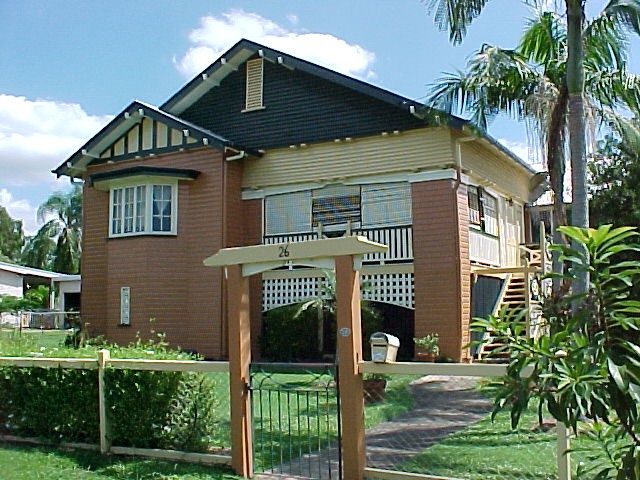Addresses
Type of place
House
Period
Interwar 1919-1939
Style
Queenslander
Addresses
Type of place
House
Period
Interwar 1919-1939
Style
Queenslander
This interwar double gable timber residence was designed by prominent Brisbane architect Eric Percival Trewern in the late 1920s for George Grant Bond, Queensland’s first Divisional Meteorologist. Located on a large block of land, this house is a fine example of Trewern’s domestic architecture, the original character of which remains largely intact.
Lot plan
L1_RP45586; L4_RP45586; L3_RP45586; L2_RP45586
Key dates
Local Heritage Place Since —
Date of Citation —
Construction
Roof: Corrugated iron;Walls: Timber
People/associations
Eric Percival Trewern (Architect);George Grant Bond (Occupant)
Criterion for listing
(H) Historical associationInteractive mapping
Lot plan
L1_RP45586; L4_RP45586; L3_RP45586; L2_RP45586
Key dates
Local Heritage Place Since —
Date of Citation —
Construction
Roof: Corrugated iron;Walls: Timber
People/associations
Eric Percival Trewern (Architect);George Grant Bond (Occupant)
Criterion for listing
(H) Historical associationInteractive mapping
History
Until the arrival of public transport in 1899, and with it an influx of new residents to the area, Enoggera was a predominantly rural area scattered with small farms, orchards and vineyards. The presence of a staging depot there during World War I also brought tens of thousands of troops to the area which furthered its residential development. Even in the 1920s the suburb still retained some of its rural character; however by the 1930s Enoggera had taken on a predominantly industrial focus with saw-mills, potteries and brick-making works becoming the dominant industries.
The block of land on which ‘Plympton’ now sits was purchased in 1895 by John Harmer Bond and a portion of it transferred to his son George Grant Bond in 1925. According to George’s daughter Isabella, ‘Plympton’ had been constructed by March 1926. While there are no postal records relating to the Bond family in Enoggera until 1929-30, the house was evidently built by 1929.
‘Plympton’ was designed by renowned Brisbane architect Eric Percival Trewern, who also designed the front paling fence specifically for the property. Victorian trained Trewern established his architectural practice in 1920 in Queen Street, Brisbane. The height of his design success occurred in the interwar period and he is renowned for his innovative designs incorporating the Spanish Mission and the Old English/Tudor revival style in residential and commercial architecture. Amongst his finest residential designs is the New Farm house ‘Santa Barbara,’ which is considered the best example of the Spanish Mission style in Brisbane. Trewern was an active member of many prestigious architectural societies in the pursuit of improving professional architectural standards in Queensland.
The Bond family were notable residents of the Enoggera community. In 1908, George Grant Bond became the first Divisional Meteorologist in Queensland, and his son, Harold George Bond, who also worked as a meteorologist, became the Tasmanian Regional Director in 1964. With only a deputy and two support staff, George Bond guided the Queensland Branch of the Commonwealth Meteorological Bureau through its infancy and fostered its growth and development. George was very dedicated to his work and felt keenly responsible for making accurate weather forecasts. However, the stress of his job appears to have taken its toll on him physically, eventually weakening his health. George lived at 26 Bond Street with his wife Millicent and their four children until his death in 1938, however the house remained in the Bond family until 1992. Bond Street was so named in 1925 at the suggestion of a Mrs. Bond as reflected in the 1925 Brisbane City Council minutes.
Since then a number of changes have been made to the house. In the 1960s the front patio was enclosed and between 2007 and 2008 extensive additions were carried out at the rear of the house where a deck was added and the kitchen expanded. The original fence, designed by Trewern, was also replaced with a wire picket fence; however in 2007 the owners had the original fence rebuilt to Trewern’s specifications including the original colour scheme to match the house. Although the house has been altered quite extensively at the rear, the majority of the house remains substantially intact and thus retains its heritage significance.
Statement of significance
Relevant assessment criteria
This is a place of local heritage significance and meets one or more of the local heritage criteria under the Heritage planning scheme policy of the Brisbane City Plan 2014. It is significant because:
References
-
Donald Watson and Judith McKay, Queensland Architects of the Nineteenth Century, South Brisbane: Queensland Museum, 1994
-
Queensland Post Office Directories
-
Historic Titles, Department of Natural Resources and Water
-
Brisbane City Council Department of Works, Detail Plan No.1402
-
Enoggera Shire Council Minutes 1925 p.57. Held by the Brisbane City Council
-
No Author 1937, ‘Picturesque Enoggera’, Courier Mail, July 11 1937, np.
-
Morgan, H 2001, Bond, Harold George, Bright Sparcs Biographical Entry, viewed 19 August 2008, < http://www.asap.unimelb.edu.au/bsparcs/biogs/P003229b.htm>
-
Morgan, H 2001, Bond, Harold George, Bright Sparcs Biographical Entry, viewed 19 August 2008, < http://www.asap.unimelb.edu.au/bsparcs/biogs/P003229b.htm>
-
Spinks, D and I. Haynes 1986, ‘The Life of George Grant Bond Early Queensland Weather Forecaster’ Metarch Papers, No. 3 October 1986, Bureau of Meteorology, also available online from: http://www.austehc.unimelb.edu.au/fam/0133.html
Citation prepared by — Brisbane City Council (page revised June 2022)
